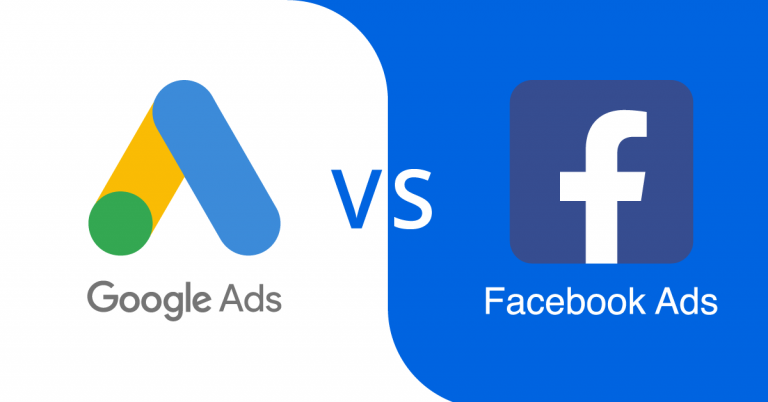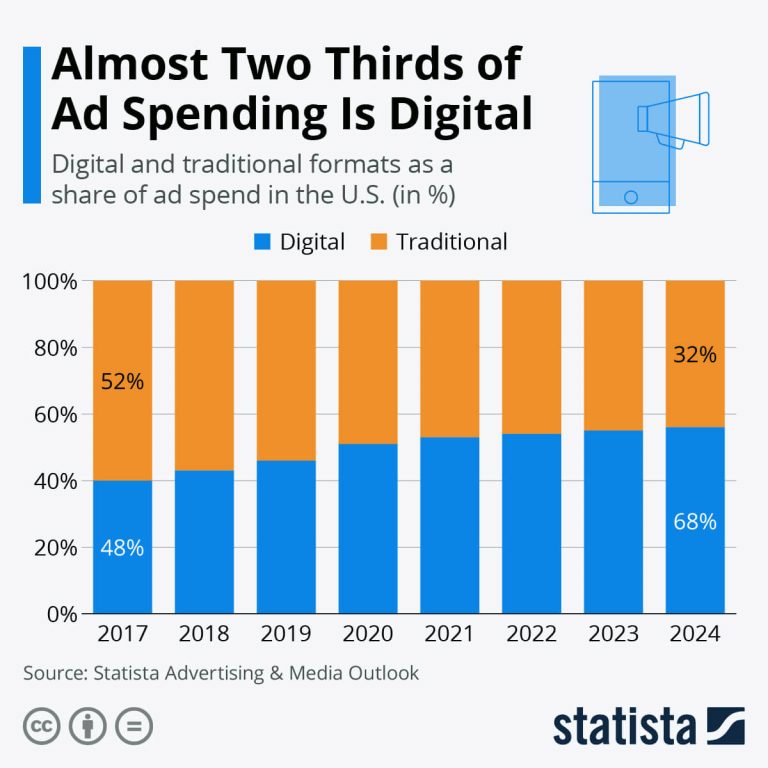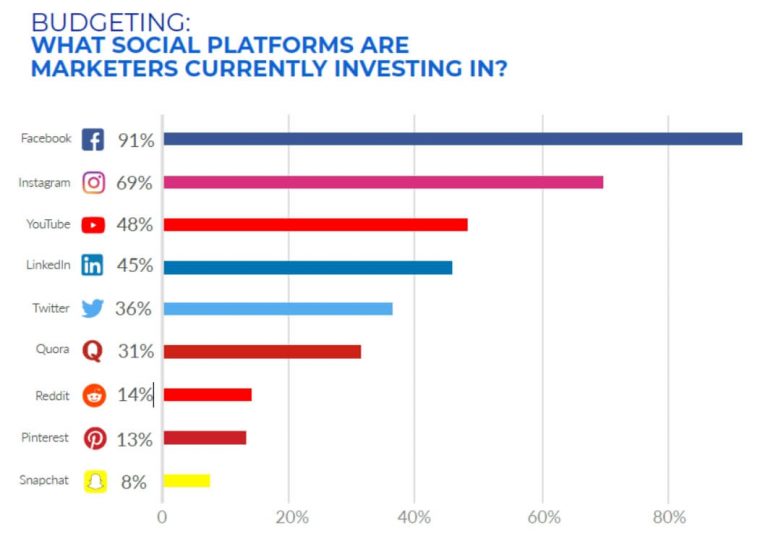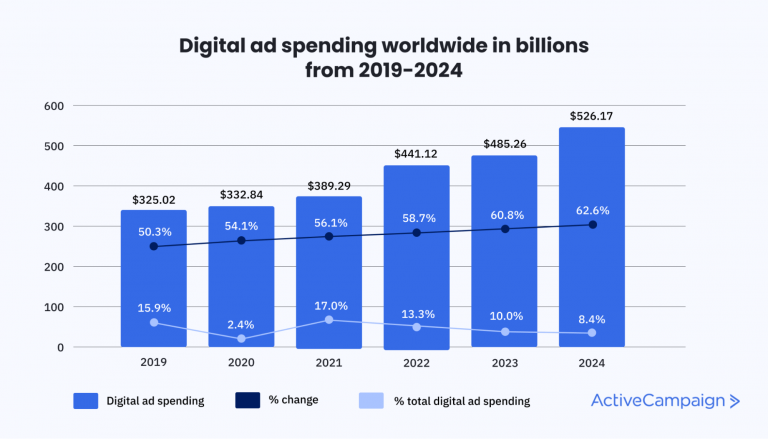
As the war between the two tech juggernauts intensifies, the age old question continues to flood marketer’s inboxes: who deserves my business’ precious advertising dollars – Facebook or Google?
Well that depends, each platform can deliver exceptional ROI – subject to the business’ target market, budget and marketing goals.
In the post below, find out the fundamental differences between the two paid advertising channels and see actionable advice on when to invest in 2022 and beyond.
Download Your Free Digital Marketing Checklist
Paid Advertising Market Snapshot
Let’s start by taking a look at paid advertising trends in Q3 2021. According to the Skai digital marketing trends report, paid social saw the biggest YoY growth with an increase of spending of up to 50% for Consumer Goods & Retail advertisers. Over the same time period, the average cost per click (CPC) for search grew 30% YoY.
Between 2017-2024 the amount of digital ad spending will increase from 48% to 68%. The rise of social advertising can be attributed to Facebook’s improved video platform stealing TV budgets.

Looking at the numbers, the future looks bright for both paid advertising methods, but which one of the category leaders should your business invest in – let’s take a closer look.
What Are Facebook Ads?
More than one third of the world’s population is active on Facebook per month, which is approximately 2.9 billion people as of December 2021. The social giant is a powerful weapon online and offers significant scale for all advertisers. According to webstrategiesinc.com, approximately 91% of marketers invest in Facebook as their social media platform of choice as of 2021.

Combining this immense scale with a goldmine of behavioural data, highly specific targeting capabilities and ever evolving ad formats, leads many marketers to make the conclusion that Facebook is the platform for them. Some may argue that Facebook advertising skews more towards brand building and top of funnel marketing activities; however this doesn’t detract from the immense value the social giant brings.
Facebook Ads Pros
Massive Scale: With over 37 percent of the world’s entire population active monthly on Facebook, in terms of audience attention the channel is what television was 50 years ago. In real time you can multiply campaign reach for a fraction of the cost you would pay for a TV or radio ad, whilst leveraging a huge number of targeting features to reach the right audience targeted specifically for your business.
Data Goldmine & Pinpoint Targeting Capabilities: Facebook keeps track of almost every imaginable data point that its 2.9 Billion active users take. With an average Facebook session lasting longer than a Google search, the volume and quality of behavioural data Facebook captures certainly passes its rival. Marketers can now deliver the perfect message to the right audience at the most opportune time which can ultimately minimise ad wastage.
Cost Effective: Facebook ads on average are cheaper than Google ads with a $1.72 cheaper CPC. In saying this, the price you pay will vary depending on how much competition there is for your target audience. There are definitely valid arguments that a single click from Google is worth more than one on Facebook because of the consumer’s stage in the decision journey.
Engaging Ad formats: Through its news feed advertising, Facebook can deliver compelling visual ads that seamlessly integrate with the user experience. These can be much more engaging than basic text ads on Google. Furthermore, Facebook boasts approximately the same number of video views a day as YouTube (which is owned by Google) at about 5 billion. Facebook continues to invest heavily in its video platform, capitalising on an increasing number of younger users who prefer online video to traditional TV formats.
Facebook Ads Cons
Interruption Marketing: Users on Facebook don’t actively rely on the platform to shop. As a result conversion rates (as an average) are generally lower on average than on Google where consumers are in buying mode.
Demographic Targeting: Targeting via demographics using specific audiences requires much trial and error to pinpoint the right audience initially, which can prove to be costly over time. Also, by making assumptions around who the target audience is you may cut out a significant portion of the market. Google on the other hand circumnavigates this problem through capturing user intent, taking out the guesswork around audience targeting.
Download Your Free Digital Marketing Checklist
What Are Google Ads?
With over 150 billion global searches being conducted each month, Google is by far the most popular and widely used search engine on the planet. Google currently has a market share of 92.47% as of June 2021.
Furthermore, research states that digital ad spending is currently increasing at a rate of approximately 2% per year. The estimated spend in 2022 is $441 billion for digital ad spending worldwide. This highlights that Google Ads is only going to continue to grow and become more competitive than ever.

Google Ads Pros
Vast Reach: Just like Facebook, Google offers massive potential reach. Google generates 63,000 queries per second, equating to around 2 trillion global searches per year. No matter what industry you’re in, you can guarantee that your target audience is looking for your products or services on Google.
Commercial Intent: The biggest advantage Google ads has over Facebook is user intent. Most consumers using the search engine are actively looking for products or services and are often in a buying state of mind.
Highly Measurable Analytics: Google houses a comprehensive analytics suite which provides a clear picture of revenue driving metrics such as cost per conversions. Using this data, you can easily identify weaknesses in your strategy and manipulate campaign variables to achieve desired marketing KPI’s.
Granular Targeting & Mobile: Google offers a plethora of granular targeting options such as location, device, time of day and day of the week. This allows for tighter control of campaigns and enables marketers to deploy advanced PPC strategies such as channelling budgets into higher converting times of the day. It also caters for the mobile centric buying habits of today’s consumer which allows marketers to develop custom targeting and bidding strategies for the mobile experience.
Rewards Quality: The most common misconception around Google Ads is that the company with the biggest budget wins, but this is not always the case. Ad rank is computed by quality score multiplied by the maximum bid price. Thus Google rewards relevancy to help create a level playing field for smaller players. Read some of our best Google ads tips for small businesses in our Google Ads guide.
Google Ads Cons
Expensive In Some Industries: Cost can be exuberant in some industries such as SEO, where cost per click prices can hover anywhere on average around the $25 mark for 1 click. Some marketers may argue that this is counteracted by high transactional and customer lifetime values (LTV’s) in an industry like this.
Takes Expertise To Manage: AdWords certainly isn’t a set and forget platform. If campaigns aren’t set up correctly or budgets not tightly managed- advertising dollars can be burnt.
Lacks Engaging Ad Formats: Google shopping and display ads aside, the platform lacks the visually engaging ad formats of its social rival.
Download Your Free Digital Marketing Checklist
Which Digital Marketing Channel Should I Invest In?
Summarising these 2 methods of digital marketing advertising can be very difficult because of the many differences in features and channels. Facebook advertising works well for brand building activities, establishing industry authority, re-activating past customers and dripping prospects through multi-stage sale funnels. Google Ads on the other hand is unparalleled in its ability to generate leads in a highly measurable way whilst capturing users attention when in a buying decision making state of mind.
Ultimately how you decide to utilise your marketing spend across Facebook and Google will be determined by your business model, target market and marketing goals. As a rule of thumb, if there is a significant volume of consumers searching for your products or services on Google, then invest there first. These customers are ready to buy and in markets with short sales cycles, like emergency plumbing, and you’ll see near instantaneous return on investment.
Many experts agree Facebook and Google work best in synergy and thus harnessing the unique strengths of each platform. A consumer is more likely to click on your Google ad if they recognise your brand from Facebook. Whilst, a consumer who discovers your brand through Google may not convert on the first visit and you could leverage Facebook’s retargeting to re-introduce them into your sales funnel. The combinations are endless and will require trial, error and meticulous optimisation to establish the perfect mix for your business.
In closing, as consumer attention becomes increasingly fragmented, adopting a multi-channel digital strategy is key to your online marketing success. Google Ads reach about 90% of internet users and Facebook Ads reach about 50%, so a single strategy on either Facebook or Google might not always capture your entire audience profile. There is no better place to start than with the two digital channels that garner the most consumer attention.


